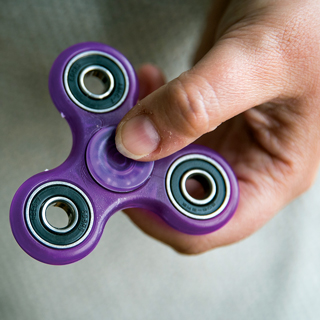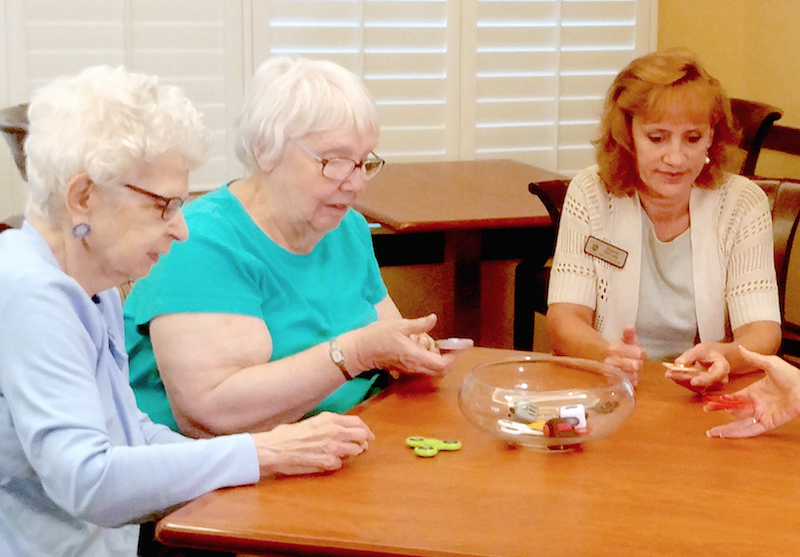
Fidget spinners have been in the news recently for the relief they appear to bring to people with anxiety, autism or attention deficit hyperactivity disorder. Alternatively, some educators have called them a distraction and have banned them from school classrooms.
But now one Ohio senior living community is finding that the ball-bearing devices, which have been said to provide an enjoyable sensory experience when spun between users’ fingers, could be more than just a passing fad; they seem to produce a calming effect in those with Alzheimer’s disease and dementia.
The Kenwood by Senior Star in Cincinnati began testing the toys in May.
“Staff brainstorming prompted the research,” Executive Director Tom Rotz told McKnight’s Senior Living. “Knowing that many interventions that have been effective with children with autism or ADHD have also been effective for those with dementia, we thought this would be beneficial to test out.”
Some residents have not shown interest in using a fidget spinner or fidget cube, Rotz said, whereas others hold one and play with it often.
“Two or three really took to it,” he said. “One, who previously was not engaged with most activities, is very engaged when using the spinner. It is great for those who want to use their hands and are unsure how. A former surgeon who is a resident of ours uses it for that very reason.”
The Kenwood by Senior Star currently is studying the use of fidget spinners in one memory care unit where nine residents live; most of them have mid-stage dementia, Rotz said. The community also has 19 residents in another memory support unit, where visitors might see fidget spinners in use, too, as news of the toy’s potential appeal spreads.
 “This program was originally targeting one resident, but we noticed others were curious, too,” said Annette DeCamp, the community’s programs and events manager for health services. (She is pictured at right in the accompanying photo, demonstrating the use of fidget spinners with independent living residents.) “We are documenting as we go and educating associates to note the little things — for example, was the resident engaged? Curious? How long did they keep the spinner or cube? Did they wander less? Did they still wander with a spinner but were quiet, less agitated, content?”
“This program was originally targeting one resident, but we noticed others were curious, too,” said Annette DeCamp, the community’s programs and events manager for health services. (She is pictured at right in the accompanying photo, demonstrating the use of fidget spinners with independent living residents.) “We are documenting as we go and educating associates to note the little things — for example, was the resident engaged? Curious? How long did they keep the spinner or cube? Did they wander less? Did they still wander with a spinner but were quiet, less agitated, content?”
The next step in the informal research, DeCamp said, is to introduce the spinners or cubes in group settings or leave several devices within arm’s reach on side tables or coffee tables to see whether residents will engage with them. “It is interesting to me that mostly men on the unit are attracted to the cube fidget with all of its rolling and clicking parts, and several tend to tuck the spinners away in their pockets,” she said.
The Kenwood by Senior Star plans to conduct the trial until November and then review all of the information that has been collected over the months, DeCamp said.
“I review documentation weekly and talk to associates if questions arise and offer suggestions as needed,” she said.
The program will be considered worthwhile, Rotz said, if even one or two residents are found to have benefited from it.
“There is no one result we want to see or a certain number of people who engage with it to consider it a success,” he said.
DeCamp agreed, noting that early results look promising.
“It is not ‘waking up’ a resident like you hear about with some of the music programs out there, and we are not trying for that with this program,” she said. “We are striving to allow a resident to self-engage with an object that can simply keep their fingers busy, slowing and calming an agitated mind.
“It is engaging those who can still hold and look at an object,” DeCamp continued. “It seems to pique a curiosity — the bright colors, shiny finish, movement or, in the case of the cube, a clicking sound. The results may be subtle, but they are there. This approach is slow but promising. We are not looking for instant; we are striving for constant, calming and a bit of independence for those who have lost that ability, with the simplicity of a newfangled toy. I am encouraged and excited.”



